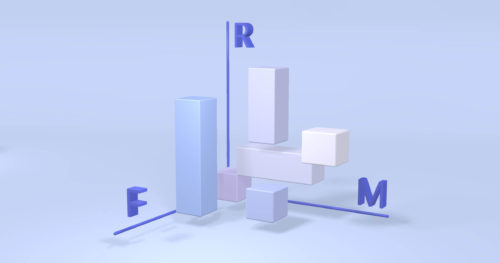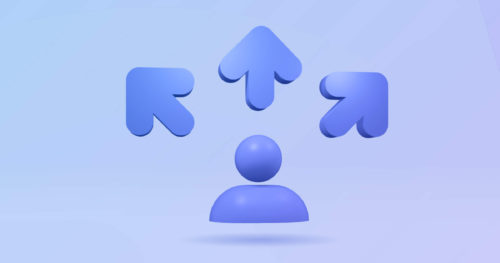One of the key features of a successful business and a successful marketing strategy is if they’re able to build customer relationships and loyalty. You want your customers to keep coming back to you, and you want a steady stream of new customers to keep coming in.
A great way of ensuring customer retention and reducing customer attrition is by analyzing actual behavioral data over time. You need to dig deeper and look past the superficial data surrounding your product in order to gain enough insight to form a strategy to reduce customer churn and gain a sustainable edge over competitors.
This method allows you to do exactly just that.
55% of customers want to use rewards across multiple brands. The easiest way for growing brands to start such a loyalty program is Monetha - Loyalty & Rewards. Ready to try?
What is Cohort Analysis?
Cohort Analysis is one of the best methods of tracking the behavior of user engagement. A cohort means people with similar traits that are treated as a group.
This analysis basically breaks down users into different groups instead of analyzing them as a whole unit. One example would be putting users who have become customers at approximately the same time into one group or cohort.
This technique is used to make it easier and more convenient for businesses and organizations to detect patterns among the lifecycles of their user groups. They’re able to isolate these patterns, allowing them to properly analyze and understand better the behavior of a user in a certain cohort (see examples of behavioral segmentation here).
Additionally, with cohort analyses, the common characteristics they share should be something they share at a specified time frame. Two users can share the same characteristic of ordering from the same restaurant but if it is not a shared moment that happens in the same given time period, then they cannot be put into one cohort.
An analysis of cohorts does not exactly point out the causes of the fluctuations in your customer retention metrics. Instead, it gives you insights into the tendencies of your users, allowing you to gain a deeper understanding of why customers may or may not be as engaging with your product or specific features of your product.
It’s an invaluable tool that shows you the potential areas that need focus to ensure a higher customer retention rate. With the right usage of the data gathered from the cohort analysis, the company is able to come up with different test campaigns and strategies to find the best value they could provide for their product and ensure customer satisfaction.
Another thing about this type of analysis is that it is essential for product-led growth. It allows you to examine trends over time and measure the responses of different groups of users to your product.
This method is a great way of comparing new and old users and the behavioral differences between them when faced with different engagement marketing strategies such as ad content, promotional campaigns, new product lines, and service discounts to name a few.
Cohort Analysis also allows you to differentiate customer engagement (see how to measure it here) from general company growth. It’s easy to assume that customers are generally satisfied with your product when the metrics go up, but it might only be a momentary peak and not necessarily a sign of growth and sustainability.
With this kind of analysis, you’re able to identify how many of these new users are turning into loyal and repeating customers, and if high acquisition numbers actually signify bigger profits in the long run.
What are Its Types?
There are mainly two types of Cohort Analysis:
1. Acquisition Cohorts
Acquisition cohorts divides users on the basis of when they acquired the product or when they signed up for it. Like any other cohort, the acquisition, or the time they signed up for a product must happen within a defined period. The acquisition event includes purchasing a product downloading an app, and registering with a brand, to name a few.
This type of cohort typically answers the questions Who and When: “Who are buying the products?” and “When did they make the first purchase?” Additionally, they are useful for identifying the number of new users that are churning for a certain period, hence enabling the organization to properly measure customer retention and customer churn rates across a specific time period.
User acquisition can be tracked daily, weekly, or monthly depending on the product.
A good example that can show how useful acquisition cohorts analyses are in the case of application developers. To measure the success of a newly launched app, you can break the number of users downloading the app into cohorts by day for the first week of launching, by week for the first month, and so on. This then allows you to see the number of people who continue to use the app from their respective starting points.
You can then see where the retention rate starts dropping. Is it after the first day of use? The first week? The first month? This narrows down the potential issues that might cause customers churn.
Of course, the data the acquisition analysis provides only shows numbers and statistics. It does not exactly go into the whys of customers churning. This is where the other type of cohort analysis becomes useful.
2. Behavioral Cohorts
In the behavioral cohorts, users are segmented and grouped based on the actions they take after they have acquired the product in a given time frame. Whether a user actually continues enjoying the product is influenced by the small behaviors and actions they exhibit. For example, using a certain feature, the frequency of posts on a social media platform, the number of TV shows they watch consecutively after subscribing to a streaming service, or the restaurant choices they make on a food delivery app.
The advantage of using the behavioral cohorts is that you gain more insight into your user base. With this, you’re able to track what people do, or don’t do, with your product.
Acquisition cohorts can’t pinpoint the exact reasons for customer retention or customer churn. But behavioral cohort analysis allows the organization to test common behaviors among users who engage with their product the most. Also, you can track to see how long they stay active once they interact with a trickier feature in your product.
Ultimately, this type of cohorts analysis allows you to observe the demand for a certain feature set and decide whether or not it’s worth investing money, time, and energy on. It reveals how engagement and interactions with your product can affect retention and revenue.
9 Cohort Analysis-Based Metrics to Measure Customer Retention
Customer retention is important to the success of a business. It describes a business’ ability to turn new customers into repeat customers. It differs from customer loyalty because this refers to the customers who are already continuously buying from a particular brand or business and not actively looking anywhere else.
Customer retention and customer loyalty are linked because customer retention is often the first step to establishing customer loyalty.
There are several metrics that you should keep track of to measure and improve customer retention:
1. Customer Retention Rate
The most obvious and straightforward metric to measure customer retention is the customer retention rate. It’s important to understand what amount of your customer pool is becoming loyal and the amount of repeat business you are generating to gain a deeper understanding of whether your business is doing well or not.
The customer retention rate is reflected as a percentage. To get this percentage, you have to subtract the number of newly acquired customers from the customers you have at the end of a period. Then, divide the result by the number of customers you had at the beginning of a period and multiply it by 100.
A better visual description of the formula is as follows:
Customer Retention Rate = ((NCE – NEW)/NCS)) x 100
where;
- NCE = Number of Customers by the End of the period
- NEW = NEW Customers acquired during the period
- NCS = Number of Customers at the Start of the period
2. Churn Rate
The churn rate measures the percentage of customers that have stopped using your product during a given time period. Typically, if an organization’s churn rate reaches 5-7% and above, it’s usually a sign for the company to examine what could be impacting their customer satisfaction and take the necessary actions.
There are two types of churn rates: the customer churn rate and the revenue churn rate.
The customer churn rate measures the rate of customers that have stopped doing business with you. This could be them canceling a subscription or discontinuing any engagement with your company.
A fun fact is that there are actually several customer churn rate formulas. It’s a topic that’s been debated heavily in marketing and data science. The simplest customer churn rate is:
Churn Rate = Number of Churned Customers / Number of Total Customers
But experts have pointed out that the growth of a business or any new customer acquisitions skews the churn rate obtained from this formula. When your company goes through a significant amount of growth, both the number of churned customers and total customers can go up. In the case of total customers increasing more, even when you have more customers churning out than the previous month, your churn will still end up decreasing.
Thus, several organizations have presented alternatives to computing customer churn rates.
The first one is as follows:
Churn Rate = (NCES – NCEE) / NCES
where;
- NCES = Number of Customers at the Start of the period
- NCEE = Number of Customers at the End of the period
The second suggested formula is:
Churn Rate = NCC / ((NCES + NEW) / 2)
where;
- NCC = Number of Churned Customers at the given period
- NCES = Number of Customers at the Start of the period
- NEW = Number of Newly Acquired Customers
There are still several other alternative formulas to computing customer churn.
Revenue Churn Rate
This type of churn rate, on the other hand, expresses the percentage of revenue that the business has lost from existing customers in a given time frame. A number of behaviors from existing customers can lead revenue to churn. This includes canceling an order, downgrading a subscription, etc.
The formula is done by monthly recurring revenue at the end of the month from the monthly recurring revenue at the start of the month, and then subtracting revenue gained from upselling or cross-selling existing customers from the result. Afterward, the result is then divided by the monthly recurring revenue at the start of the month.
(MRR at the Start of Month – MRR at the End of Month) – Revenue Gained / MRR at the Start of Month
Revenue Churn is calculated in monthly intervals. Additionally, getting a negative revenue churn rate is a good thing because it means that the revenue gained from existing customers outweighs any revenue losses incurred during the month.
3. Existing Customer Revenue Growth Rate
Essentially, this metric measures the amount of revenue you are generating from customer success, retention, and loyalty. If this rate continues to rise, then this means that the marketing team is doing a good job of upselling, cross-selling, increasing purchase frequency, etc. Otherwise, the existing customer revenue growth rate will flatten or fall.
A stagnant existing customer revenue growth rate is also dangerous because it shows that your company isn’t growing and making any improvements. This could pose an issue for the sustainability of your business in the long run.
To calculate the rate, you should subtract monthly recurring revenue from existing customers at the start of the month from the monthly recurring revenue from existing customers at the end of the month. The result is then divided by the monthly recurring revenue from existing customers at the start of the month.
Existing Customer Revenue Growth Rate = (MRRE – MRRS) / MRRS
where;
- MRRE = Monthly Recurring Revenue from existing customers at the End of the month
- MRRS = Monthly Recurring Revenue from existing customers at the Start of the month
It’s important to keep in mind that this metric is only measured monthly. Additionally, you should exclude any revenue generated from newly acquired customers.
4. Net Incremental Revenue
This metric focuses on the change in net revenue generated by a company after increasing the quantity being sold i.e running a promotional offer. The cost of doing such an activity is also taken into account.
To calculate total Net Incremental Revenue, you should first compute for the total revenue.
The Total Revenue is calculated by subtracting the incentive costs from the qualifying revenue. Then, once you have your Total Revenue, the next thing you should compute is the Net Revenue per Customer, which is equal to the Total Revenue divided by the number of customers.
The Net Revenue per Customer is calculated separately for test and control.
You then calculate the Net Incremental Revenue per Customer by subtracting the Net Revenue per Customer from Control from the Net Revenue per Customer from Test. Then, you multiply the result by the number of Test Customers to get the Total Net Incremental Revenue.
Efficiency can also be calculated by dividing the Total Net Incremental Revenue by the Incentive Costs.
The Net Incremental Revenue metric is an essential measurement because it helps tie the market to the much larger goals of the business. It also helps executives gain an understanding of the impact of a program and prove the ROI of marketing.
5. Repeat Purchase Ratio
The Repeat Purchase Ratio is also known as the Loyal Customer Rate. It measures the percentage of customers that frequently does business with you in a given time frame. This is also a great way for the marketing and sales team to assess and evaluate the impact of the customer retention strategy that the company has employed. Although, this metric can be a skewed way of measuring customer loyalty as it does not take into account individual customer behavior.
An example would be a clothing retailer that has customers who only make a couple of bulk purchases every year or every season while other customers make frequent purchases per month. It does not take into account the loyalty of the other customer who only makes large purchases a couple of times a year.
This metric usually applies to tangible products but it can also be used for repeat subscription or contract renewals.
To calculate the Repeat Purchase Ratio, you should the Number of Returning Customers in a given time period by the Number of Total Customers in a given time period.
This formula can be calculated weekly, monthly, yearly, or any other time span that the business chooses to use.
The Repeat Purchase Ratio is also especially useful for their applications to specific demographics. Being able to identify which types of consumers are making the most repeat purchases allows the company to adjust its target buyers. The marketing and sales team will also have an idea of where to concentrate their efforts on.
6. Daily, Weekly, and Monthly Active Users
A sign of churn is usually when customers start engaging less with your product. The way to prevent this is by making sure your users stay engaged. This can be done by analyzing the gathered behavioral data and using it to come up with a strategy for the best activity the company can employ to keep the customers engaged.
It’s then important to monitor the activity and engagement afterward. If the engagement benchmark still is not met, then new strategies should be employed.
7. Customer Lifetime Value
The Customer Lifetime Value metric measures the revenue generated from a single customer. It also provides a clear picture of what the business will be like in the long term and its financial viability. A high Customer Lifetime Value is a good indicator of product-market fit, brand loyalty, and a good amount of recurring revenue from existing customers.
To calculate the Customer Lifetime Value, you must first divide the company’s gross sales by the total number of unique customers for the year. This result shows the average amount of revenue you can expect from a customer over the course of a year. Then, multiply the result by the average lifespan of your customer based on gathered data about how long a customer usually stays with your business in terms of years.
8. Product Return Rate
Product Return Rate, as the name suggests, measures the percentage of products sold that have then been sent back to you. This is only applicable to businesses that sell tangible products.
To calculate the Product Return Rate, multiply the Number of Units Returned by the Total Number of Units Sold.
You’d typically want your Product Return Rate to be as close to zero as possible. But, in reality, the average return rates can end up being much higher, ranging from eight percent to fifty percent depending on the product sold. Regardless, the Product Return Rate is definitely an important metric to help start the damage control process when necessary and use the information to figure out which aspects of the product or the delivery should be improved.
9. Net Promoter Score
This metric measures customer satisfaction and how likely they are to recommend your business to others. The Net Promoter Score indicates the customer’s overall satisfaction with your brand and their loyalty to it.
To be able to calculate this rate, you must first conduct a survey asking your customers how likely they are to promote the business to others on a scale of 0 to 10. Those who give a score of 9 or 10 are considered to be the promoters. Meanwhile, those who give a score of 6 and below are considered to be the Detractors.
The formula then for computing the Net Promoter Score is by subtracting the percentage of Detractors from the percentage of Promoters.
Conclusion
In the end, a business is all about that customer relationship. If you do not put customer satisfaction first when developing your product and services, then it is unlikely that your business can be sustainable at all. A proper cohort analysis definitely helps a lot with this.
You’re able to properly track trends of user engagement and narrow down any potential issues that you can intervene in to make sure your customers stay satisfied. Customer retention rate is definitely an important measurement of the overall success of a marketing strategy but it’s the cohort analysis that provides a visual of that. By being able to understand your customer’s behaviors and preferences, you’re able to foster existing customer relationships and create new ones that last long.
Are you interested in automatically generated cohort analysis?
Start using Verfacto and get: cohort analysis, RFM segmentations and many other advanced reports.
FAQs
What is a Good Cohort Retention?
Cohort Retention generally is a sign of how healthy and successful a business is. If you want to ensure the sustainability of your business, then you must aim for a high cohort or customer retention rate. A higher rate typically means that customers are satisfied with your business. This is also a good indicator of high customer loyalty.
Ideally, you would want your cohort retention rate to be at 100%. It usually varies among industries. The benchmark for retention rates per industry is as follows:
Retail: 63%
Banking 75%
IT Services: 81%
Insurance: 83%
Telecom: 78%
Finding out the average cohort retention rate in the industry you belong to might help in figuring out a strategy to ensure a higher than average rate.




